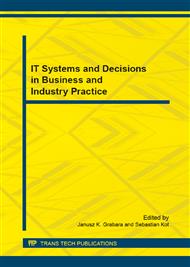p.16
p.24
p.31
p.39
p.47
p.53
p.61
p.69
p.77
Performance Measurement and Risk Management Framework of the Enterprise’s Integrated in Logistic Chains in the Context of the Information Society
Abstract:
The intensified competition, the frequent change of the clients’ preferences and the globalization of the capital, product, service and information flows have turned the efficient product management into an essential factor for increasing competitiveness in production systems integrated in supply chains. In this context, industrial excellence can be obtained only by an efficient process piloting, using some performance measurement systems that permit a good substantiation of the decisions based on correct and reliable information, taking into account the risks specific to supply chains. The paper includes a review of the literature in the field of performance measurement for supply chains to understand the current practice and contributes to the development of the supply chain performance measurement framework using risk management, the case study method, a statistic quantitative data analysis and modern performance measurement techniques such as: balanced scorecard and supply chain operation reference.
Info:
Periodical:
Pages:
47-52
Citation:
Online since:
October 2015
Authors:
Price:
Сopyright:
© 2015 Trans Tech Publications Ltd. All Rights Reserved
Share:
Citation:


